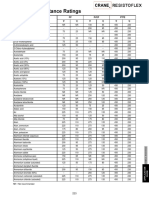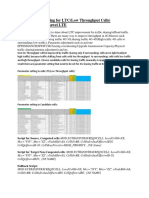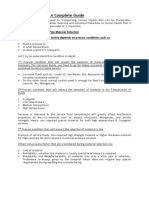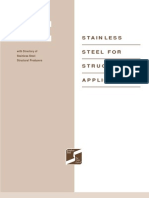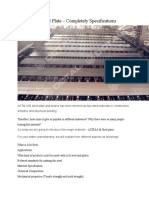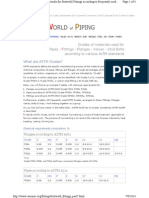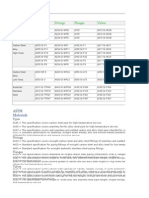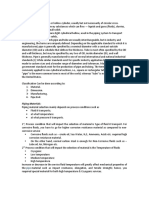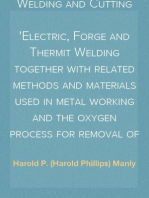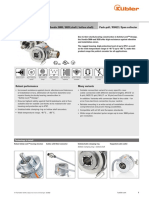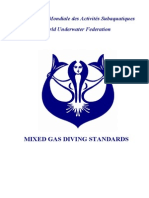Valve Material Script
Uploaded by
Ranjani J DeepakValve Material Script
Uploaded by
Ranjani J DeepakValve Material
Welcome back. In this section, I will give you an overview of valve material. The
choice of material is usually based on fluid properties such as pressure,
temperature, corrosion resistance, abrasion, and also on valve manufacturing
methods.
ASME B16.34 – Standard for Flanged, Threaded and Welding End valves gives
the list of material that can be used to manufacture the valve.
• Carbon steel
• Alloy Steel
• Stainless Steel (300 & 400 Series)
• Non- Ferrous material such as Brass, Aluminum Bronze, Monel, Stellite,
Hetelloy C are the most common material type that used to
manufacture various parts of the valve.
Valve bill of material can be segregated into three groups, material for body &
bonnet, material for trim parts such as disk, seat, stem and material for
external parts such as Hand wheel, lever, and bolting material.
Trim External Parts
Body /Bonnet
(Disk, Seat, Stem) Hand wheel, Stud
•Carbon Steel •400 Series SS •Aluminum
•Low Alloy Steel •Duplex SS •Cast Iron
•Stainless Steel •Monel •Low alloy Steel
•Titanium •Non – ferrous
alloy (Ni,Cu,Al)
•Elastomers
(PTFE, EPDM,
Viton
I am holding the slide for a moment, have look on the list of the commonly
used material.
Material for - Body /Bonnet
ASTM A 105 - Standard Specification for Carbon Steel Forgings for Piping
Applications is the most famous material grade that used to manufacture
forged valve.
ASTM A 216 is a Standard Specification for Carbon Steel Castings, Suitable for
Fusion Welding, for High-Temperature Service. ASTM A216 grade WCB is the
most popular valve body material and used for non-corrosive liquids, and
gasses. WCB stand for weldable cast body. Carbon steel material can be used
up to 426 degrees centigrade. Above that temperature, alloy steel is used.
Most common alloy steel grades are A182 and A217. ASTM A182 is Standard
Specification for Forged or Rolled Alloy and Stainless Steel Pipe Flanges, Forged
Fittings, Valves and Parts for High-Temperature Service.
ASTM A217 is Standard Specification for Martensitic Stainless, and Alloy Steel
Castings, for Pressure-Containing Parts, Suitable for High-Temperature Service.
For low-temperature applications, ASTM A350 is used that is a Standard
Specification for Carbon and Low-Alloy Steel Forgings, Requiring Notch
Toughness Testing for Piping Components.
Most common stainless steel grades are A182, A351, and A352.
ASTM A351 is a Standard Specification for Austenitic Castings, for Pressure-
Containing Parts. ASTM A 352 is a Standard Specification for Ferritic and
Martensitic, Steel Castings, for Pressure-Containing Parts, Suitable for Low-
Temperature Service.
This is the end of this lecture. In next lecture, you will learn about material of
trim, gasket and handwheel.
Material of construction – Trim
Welcome back. In this lecture, you will learn about material of trim, gasket and
handwheel.
• Trim material such as Disk, seat, stem, back sheet and sleeves are
grouped together and assigned one number called Trim No. or
Combination number. This will element the requirement of defining
material grade for each component.
• API 600 & 602 gives the list of Trim material that can be used in the
valve.
• Most common trim grades are ASTM A410(13Cr), ASTM A316, Alloy 20
(19Cr-29Ni), and Monel (CuNi Alloy).
Here you can see the simplified chart of the trim material. Against trim
number, material for seat, disc, backseat and stem is specified. This make
easier to order the valve as you just have to specified trim no based on the
requirements and need not to specify the material for each of the part. This list
is included in resource section.
Bolting Material
• ASME B16.34 gives the list of bolting material under table 1 group 4
material. Most carbon steel and alloy steel valve come with ASTM A 193
grades.
Gasket Materials
All body bonnet type valve design used a gasket to achieved sealing of body-
bonnet joint. Spiral wound gasket without an inner and outer ring or metal
jacketed gasket are used in the most valves. High-pressure valves are equipped
with ring type gasket.
Handwheel Materials
Selection of manual actuators such as hand wheel and lever depends on cost
and environment conditions in which valve is going to used. Most valves come
with carbon steel handwheel and lever. However, valve use in a highly
corrosive environment such as offshore platform may use aluminium. Most
lever type valve is fitted with elastomer cap for proper gripping while
operating the valve.
This is end of the section. In this section, you have learned about commonly
used valve material and the identification of trim material based on trim
number.
In next section, you will learn about standard and specification used to design,
manufacture and testing of valve.
You might also like
- Parts Manual RT12-RT24 053-2438 Issue 8No ratings yetParts Manual RT12-RT24 053-2438 Issue 8167 pages
- Polysilicom MFG Facility RIL Jamnagar ProjectNo ratings yetPolysilicom MFG Facility RIL Jamnagar Project1,364 pages
- Carbon & Alloy Steels Nomenclatura AISI SAENo ratings yetCarbon & Alloy Steels Nomenclatura AISI SAE51 pages
- Dimensions, Weights and Properties of Special and Standard Structural Steel Shapes Manufactured by Bethlehem Steel CompanyFrom EverandDimensions, Weights and Properties of Special and Standard Structural Steel Shapes Manufactured by Bethlehem Steel CompanyNo ratings yet
- Resistoflex Plastic Lined Pipe Ptfe Pfa PVDF PP Chemical Resistance ChartNo ratings yetResistoflex Plastic Lined Pipe Ptfe Pfa PVDF PP Chemical Resistance Chart14 pages
- 4G-4G Traffic Sharing For LTC (Low Throughput Cells) Improvement in Huawei LTENo ratings yet4G-4G Traffic Sharing For LTC (Low Throughput Cells) Improvement in Huawei LTE3 pages
- Stainless Steel Structure Design HandbookNo ratings yetStainless Steel Structure Design Handbook20 pages
- ASTM A36 Steel Plate - Completely Specifications: What IsNo ratings yetASTM A36 Steel Plate - Completely Specifications: What Is2 pages
- ASTM A36 Steel Plate - Completely Specifications: What IsNo ratings yetASTM A36 Steel Plate - Completely Specifications: What Is3 pages
- ASTM A36 Steel Plate - Completely SpecificationsNo ratings yetASTM A36 Steel Plate - Completely Specifications3 pages
- ASTM A36 Steel Plate - Completely SpecificationsNo ratings yetASTM A36 Steel Plate - Completely Specifications3 pages
- ASTM A36 Steel Plate - Completely SpecificationsNo ratings yetASTM A36 Steel Plate - Completely Specifications3 pages
- ASTM A36 Steel Plate - Completely SpecificationsNo ratings yetASTM A36 Steel Plate - Completely Specifications3 pages
- Completely Specifications: What Is ASTM A36No ratings yetCompletely Specifications: What Is ASTM A363 pages
- Steel Fasteners: Materials - Carbon & Alloy SteelsNo ratings yetSteel Fasteners: Materials - Carbon & Alloy Steels1 page
- SSINA - Designer's Handbook - Stainless Steel FastenersNo ratings yetSSINA - Designer's Handbook - Stainless Steel Fasteners23 pages
- Generally The Materials Used For Structures Fall Into The Category of A Welded Steel Structure With Castings As Reinforcement in Critical AreasNo ratings yetGenerally The Materials Used For Structures Fall Into The Category of A Welded Steel Structure With Castings As Reinforcement in Critical Areas4 pages
- HTTP WWW - Wermac.org Fittings Buttweld Fittings Part5100% (1)HTTP WWW - Wermac.org Fittings Buttweld Fittings Part54 pages
- Fasteners, its grade identification and tightening torquesNo ratings yetFasteners, its grade identification and tightening torques38 pages
- Basic Rules For Stainless Steel SpecificationNo ratings yetBasic Rules For Stainless Steel Specification9 pages
- Euro Steel ASTM Standards For Pipe FittingsNo ratings yetEuro Steel ASTM Standards For Pipe Fittings10 pages
- Why A36 Steel Plate Is The Top Rated Material in ConstructionsNo ratings yetWhy A36 Steel Plate Is The Top Rated Material in Constructions2 pages
- What Are Astm A286 and ASTM A193 B7 BoltsNo ratings yetWhat Are Astm A286 and ASTM A193 B7 Bolts2 pages
- How To Get High Quality Weldoflange or NipoflangeNo ratings yetHow To Get High Quality Weldoflange or Nipoflange7 pages
- Blacksmithing on the Farm - With Information on the Materials, Tools and Methods of the BlacksmithFrom EverandBlacksmithing on the Farm - With Information on the Materials, Tools and Methods of the BlacksmithNo ratings yet
- Oxy-Acetylene Welding and Cutting Electric, Forge and Thermit Welding together with related methods and materials used in metal working and the oxygen process for removal of carbonFrom EverandOxy-Acetylene Welding and Cutting Electric, Forge and Thermit Welding together with related methods and materials used in metal working and the oxygen process for removal of carbonNo ratings yet
- Heat-Treatment of Steel: A Comprehensive Treatise on the Hardening, Tempering, Annealing and Casehardening of Various Kinds of Steel: Including High-speed, High-Carbon, Alloy and Low Carbon Steels, Together with Chapters on Heat-Treating Furnaces and on Hardness TestingFrom EverandHeat-Treatment of Steel: A Comprehensive Treatise on the Hardening, Tempering, Annealing and Casehardening of Various Kinds of Steel: Including High-speed, High-Carbon, Alloy and Low Carbon Steels, Together with Chapters on Heat-Treating Furnaces and on Hardness Testing1/5 (1)
- A Practical Workshop Companion for Tin, Sheet Iron, and Copper Plate Workers: Containing Rules for Describing Various Kinds of Patterns used by Tin, Sheet Iron, and Copper Plate Workers, Practical Geometry, Mensuration of Surfaces and Solids, Tables of the Weights of Metals, Lead Pipe, Tables of Areas and CircumferencesFrom EverandA Practical Workshop Companion for Tin, Sheet Iron, and Copper Plate Workers: Containing Rules for Describing Various Kinds of Patterns used by Tin, Sheet Iron, and Copper Plate Workers, Practical Geometry, Mensuration of Surfaces and Solids, Tables of the Weights of Metals, Lead Pipe, Tables of Areas and CircumferencesNo ratings yet
- Classic Handplanes and Joinery: Essential Tips and Techniques for WoodworkersFrom EverandClassic Handplanes and Joinery: Essential Tips and Techniques for WoodworkersNo ratings yet
- American Blacksmithing, Toolsmiths' and Steelworkers' Manual - It Comprises Particulars and Details Regarding:: the Anvil, Tool Table, Sledge, Tongs, Hammers, How to use Them, Correct Position at an Anvil, Welding, Tube Expanding, the Horse, Anatomy of the Foot, Horseshoes, Horseshoeing, Hardening a Plowshare and BabbitingFrom EverandAmerican Blacksmithing, Toolsmiths' and Steelworkers' Manual - It Comprises Particulars and Details Regarding:: the Anvil, Tool Table, Sledge, Tongs, Hammers, How to use Them, Correct Position at an Anvil, Welding, Tube Expanding, the Horse, Anatomy of the Foot, Horseshoes, Horseshoeing, Hardening a Plowshare and BabbitingNo ratings yet
- Academia Summary - Mechanical Constraints On Thermal Design of Shell and Tube ExchangersNo ratings yetAcademia Summary - Mechanical Constraints On Thermal Design of Shell and Tube Exchangers3 pages
- 3 Shell and Tube Heat Exchanger Features That Affect Shell-Side Pressure DropNo ratings yet3 Shell and Tube Heat Exchanger Features That Affect Shell-Side Pressure Drop10 pages
- What's The Difference Between Parallel Flow, Counter Flow and Crossflow Heat ExchangersNo ratings yetWhat's The Difference Between Parallel Flow, Counter Flow and Crossflow Heat Exchangers7 pages
- Academia Summary - Shell and Tube Heat Exchangers Using Cooling WaterNo ratings yetAcademia Summary - Shell and Tube Heat Exchangers Using Cooling Water3 pages
- Academia Summary - Selection of Heat Exchanger TypesNo ratings yetAcademia Summary - Selection of Heat Exchanger Types3 pages
- Academia Summary - Air Cooled Heat Exchanger DesignNo ratings yetAcademia Summary - Air Cooled Heat Exchanger Design2 pages
- Tanquillas Plasticas Gas y Agua CiudadesNo ratings yetTanquillas Plasticas Gas y Agua Ciudades17 pages
- The Danger of Burning Plastic: Why Are Cancer Rates So High?No ratings yetThe Danger of Burning Plastic: Why Are Cancer Rates So High?8 pages
- OMN-FAC-275 Shaft Sealing Systems For Centrifugal and Rotary Pumps (Comments To API 682 4th Ed)No ratings yetOMN-FAC-275 Shaft Sealing Systems For Centrifugal and Rotary Pumps (Comments To API 682 4th Ed)16 pages
- 2271 2019 BWSC Regulations Release Version 2No ratings yet2271 2019 BWSC Regulations Release Version 263 pages
- Wellbore Stability - Principles and Analysis in Geothermal Well DrillingNo ratings yetWellbore Stability - Principles and Analysis in Geothermal Well Drilling84 pages
- SC/V - Valve Actuator Double Acting: Instruction Manual 5017No ratings yetSC/V - Valve Actuator Double Acting: Instruction Manual 501742 pages
- ICT Project Management Status Checklist.No ratings yetICT Project Management Status Checklist.3 pages






